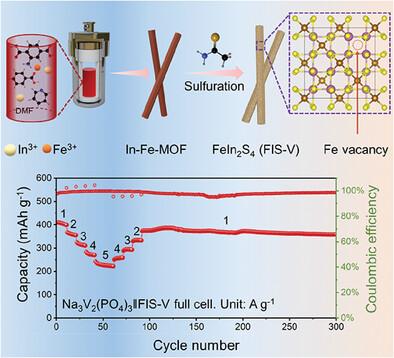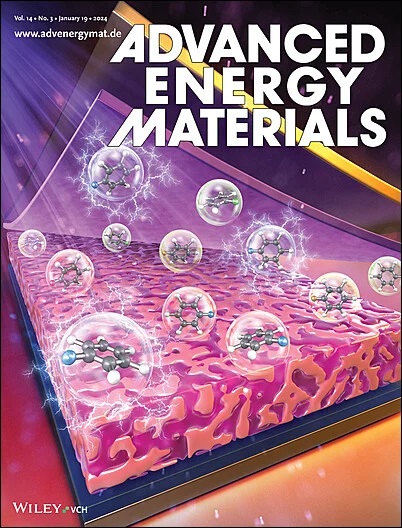在硫尖晶石FeIn2S4中构建铁空位以调节铁d -带中心并加速钠盐沉淀动力学,实现高速率和持久的钠盐储存
IF 24.4
1区 材料科学
Q1 CHEMISTRY, PHYSICAL
引用次数: 0
摘要
双金属协同效应和复合转化/合金化机制赋予硫尖晶石FeIn2S4作为钠离子电池负极材料的巨大潜力。然而,它们的合成不一致,严重的体积膨胀和缓慢的反应动力学通常导致令人不满意的循环稳定性和速率能力。本文提出了具有铁空位的双金属有机骨架衍生的FeIn2S4@N/S-C微棒,用于快速,耐用和可逆的钠储存。铁空位的存在显著调节了铁的d带中心,降低了铁- S键的强度,促进了协同酸化反应动力学。此外,通过铁空位感应形成了一层薄而稳定的富含无机成分的固体电解质界面膜。结合N, S共掺杂多孔碳基体,最佳样品在10 A g−1下具有优异的381 mAh g−1的倍率能力,并且在1 A g−1下循环500次后具有稳定的448 mAh g−1的循环性能。此外,组装后的全电池在经过倍率和长期循环评价后的容量保持率达到87.5%,表现出优异的电化学性能。这项工作为双金属硫化物作为sib先进阳极的结构调节提供了一个有前途的策略。本文章由计算机程序翻译,如有差异,请以英文原文为准。

Constructing Iron Vacancies in Thiospinel FeIn2S4 to Modulate Fe D-Band Center and Accelerate Sodiation Kinetics Enabling High-Rate and Durable Sodium Storage
The bimetallic synergies effect and combined conversion/alloying mechanism endow thiospinel FeIn2S4 with great potential as an anode material for sodium-ion batteries (SIBs). However, their inconsistent synthesis, severe volumetric expansion, and sluggish reaction kinetics typically lead to unsatisfactory cyclic stability and rate capability. Herein, bimetallic organic framework derived FeIn2S4@N/S-C microrods with Fe vacancies is presented for fast, durable, and reversible sodium storage. The presence of Fe vacancies significantly modulates the d-band center of Fe and decreases the strength of the Fe─S bond for facilitating the sodiation reaction kinetics jointly. Moreover, a thin and stable solid electrolyte interface film with inorganic-rich components is formed by Fe vacancies induction. Combined with the N, S co-doped porous carbon matrix, the optimal sample delivers an excellent rate capability of 381 mAh g−1 at 10 A g−1 and a stable cyclic performance (448 mAh g−1 after 500 cycles at 1 A g−1). Furthermore, the assembled full-cells also exhibit superior electrochemical performance with 87.5% capacity retention after rate and long-term cyclic evaluations. This work presents a promising strategy for the structural regulation of bimetallic sulfides as advanced anodes for SIBs.
求助全文
通过发布文献求助,成功后即可免费获取论文全文。
去求助
来源期刊

Advanced Energy Materials
CHEMISTRY, PHYSICAL-ENERGY & FUELS
CiteScore
41.90
自引率
4.00%
发文量
889
审稿时长
1.4 months
期刊介绍:
Established in 2011, Advanced Energy Materials is an international, interdisciplinary, English-language journal that focuses on materials used in energy harvesting, conversion, and storage. It is regarded as a top-quality journal alongside Advanced Materials, Advanced Functional Materials, and Small.
With a 2022 Impact Factor of 27.8, Advanced Energy Materials is considered a prime source for the best energy-related research. The journal covers a wide range of topics in energy-related research, including organic and inorganic photovoltaics, batteries and supercapacitors, fuel cells, hydrogen generation and storage, thermoelectrics, water splitting and photocatalysis, solar fuels and thermosolar power, magnetocalorics, and piezoelectronics.
The readership of Advanced Energy Materials includes materials scientists, chemists, physicists, and engineers in both academia and industry. The journal is indexed in various databases and collections, such as Advanced Technologies & Aerospace Database, FIZ Karlsruhe, INSPEC (IET), Science Citation Index Expanded, Technology Collection, and Web of Science, among others.
 求助内容:
求助内容: 应助结果提醒方式:
应助结果提醒方式:


